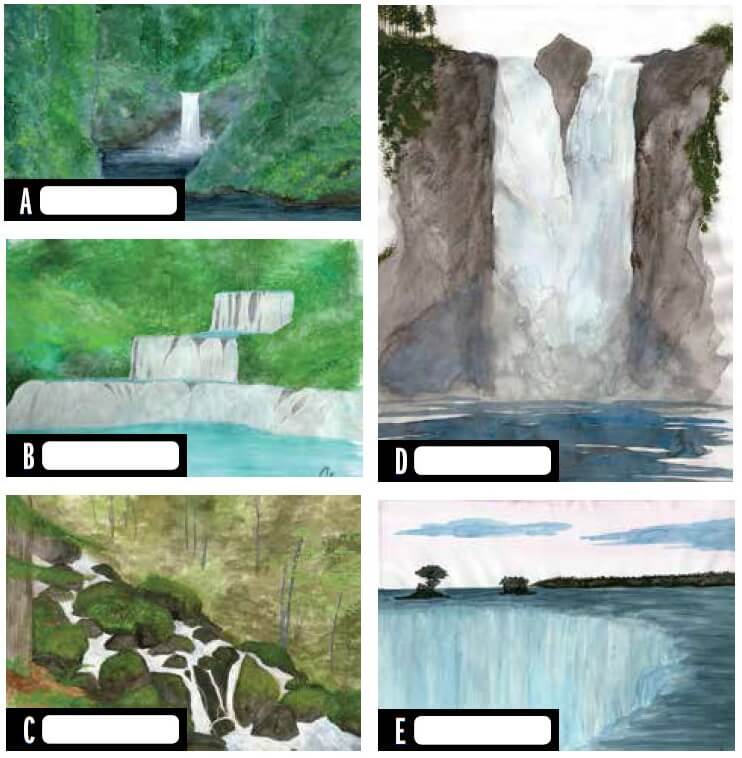Text and watercolors by Stacia Martineau
In exploring our beautiful, river-crossed state, one can’t help but come across water flowing—and with flowing water come waterfalls. A waterfall is, simply, a body of water falling over a steep precipice or incline at least three feet high. But this simple definition allows for myriad complex possibilities; there are, in fact, more than 16 different kinds of waterfalls! Here are the basic seven:
1) Cascade: water descending over an uneven surface. This can be gradual, stepped or steep, smooth or rough. A few types of cascade waterfalls include:
- Horsetail: tall and narrow, it maintains constant contact with the bedrock.
- Fan: spreads out as it falls so that the base is wider than the top.
- Slide: maintains constant contact with a smooth, gradual bedrock slope (usually granite).
2) Cataract or Plunge: large amounts of water descending vertically and losing almost all contact with the rock surface.
3) Sheet or Block: occurs when the width of the waterfall is greater than its height.
4) Curtain: very similar to a cataract but with less water. These waterfalls must be taller than they are wide.
5) Punchbowl: a narrow stream descending vertically into a larger, deeper pool.
6) Tiered: two or more smaller waterfalls descending in a quick series.
7) Segmented: split into two or more paths due to diverted channels in the stream or river above.
An added bonus: waterfalls can be any combination of these basic types. You can have a segmented cataract or a tiered sheet. The possibilities are infinite!
The unique shape of a waterfall is often a result of the geology of the area. Most waterfalls form when a river or stream flows from stronger rock to weaker rock. The weaker rock is more sensitive to the process of erosion—where large rocks are broken down into smaller rocks by wind and water—and, as a result, will erode faster. After a few thousand years, the weaker rock will give way to a plunge pool, the deeper water at the base of a waterfall. At the same time, the river or stream will slowly carve into the cliff, ultimately creating a gorge or ravine.

Answering the question “What is a waterfall?” is much more complicated than a simple dictionary definition. That’s why waterfalls are so much fun! This summer, get out into the mountains and find some waterfalls. Ask yourself: What kind of waterfall is it? What do the rocks look like? How might it look in a thousand years?
Stacia Martineau grew up in Shoreline, WA, between the Olympic and Cascade Mountains, where she goes hiking with her family and two dogs, Titan and Luna. She is currently studying geology and plans to graduate from UM in December. She wrote this piece for the Global Water: Writing in Geosciences class at UM.

WATERFALL QUIZ:
Can you match up the picture with the type of waterfall?
- Cascade
- Cataract
- Sheet
- Punchbowl
- Tiered
This article was originally published in the Spring/Summer 2014 issue of Montana Naturalist magazine, and may not be reproduced in part or in whole without the written consent of the Montana Natural History Center. ©2014 The Montana Natural History Center.
Click here to read more articles from Montana Naturalist magazine.
Want to learn more about our programs? Sign up for our e-newsletter! You can also become a member and get discounts on our programs as well as free reciprocal admission to 300+ science centers in North America!












